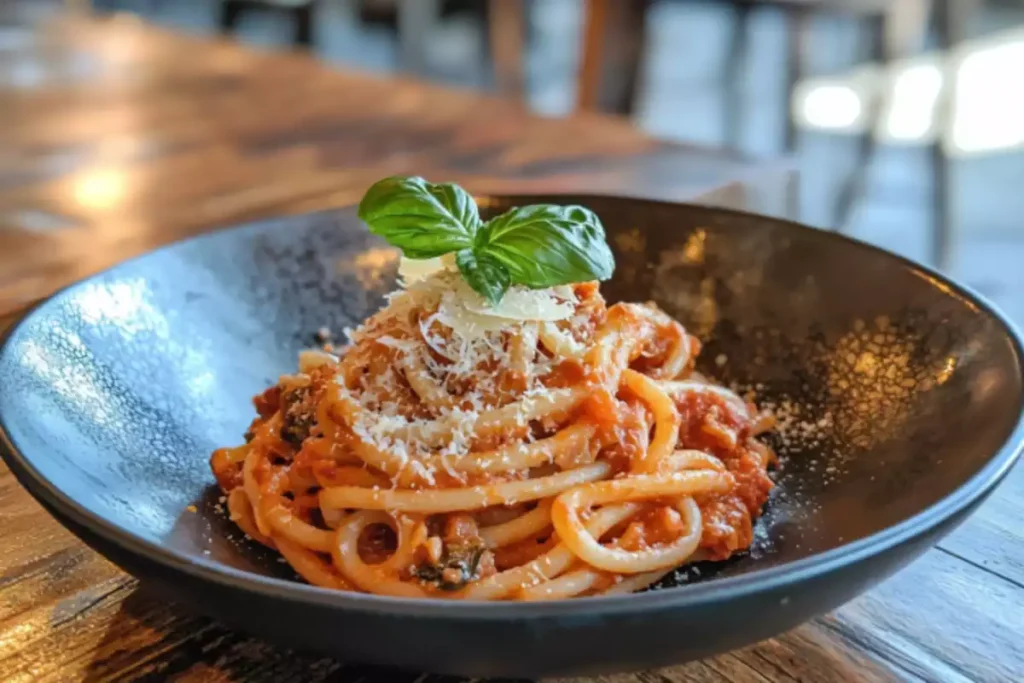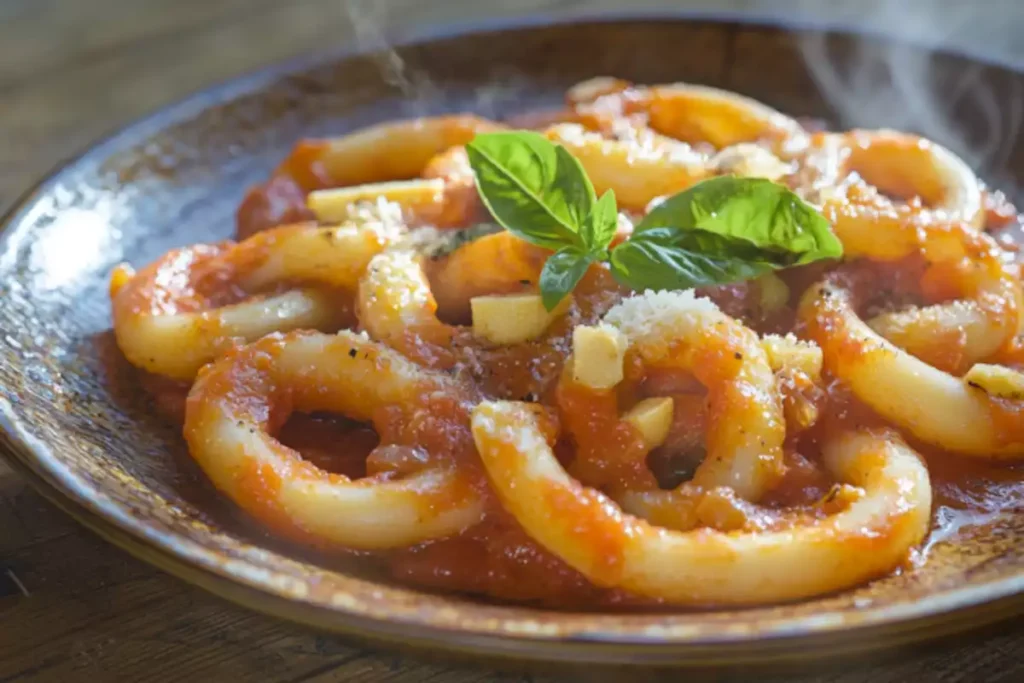
When it comes to pasta, few types evoke curiosity quite like bucatini. At first glance, it looks like spaghetti but with one notable twist: a hollow center running through its length. This small but significant difference raises the question, “What is the point of bucatini?” In this article, we’ll dive deep into the unique characteristics of bucatini, explore its culinary versatility, and reveal why this beloved pasta shape holds a special place in Italian cuisine.
What Is Bucatini?
Bucatini is a long, tubular pasta similar in shape to spaghetti but distinguished by its hollow core. The name “bucatini” comes from the Italian word “buco,” meaning “hole.” This hole runs through the length of the pasta, creating a versatile shape that can hold sauce both on the outside and inside, making every bite a burst of flavor.
The History of Bucatini
The origins of bucatini date back to ancient Rome, where pasta was first developed and experimented with. Its tubular design emerged from a desire to create pasta that could better capture and hold sauces, ensuring a flavorful experience with every bite. Today, bucatini remains a staple in Italian kitchens, particularly in regions like Lazio, home of the iconic Bucatini all’Amatriciana.
What Is the Point of Bucatini?
The unique point of bucatini lies in its design and functionality. Here’s why bucatini stands out in the world of pasta:
1. Sauce Retention
The hollow core allows bucatini to capture sauces, providing a more robust flavor in every bite. While spaghetti may only coat on the surface, bucatini delivers an added layer of flavor by carrying sauce both inside and out.
2. Texture and Bite
Bucatini’s thicker structure gives it a satisfying chew, making it a heartier choice than thinner pastas like spaghetti or linguine. This texture is especially appealing when paired with rich, chunky sauces.
3. Versatility in Recipes
From creamy Alfredo sauces to oil-based aglio e olio, bucatini works well with a variety of sauces. The tubular design also makes it ideal for baked pasta dishes or cold pasta salads.
4. Aesthetic Appeal
There’s something undeniably fun and unique about bucatini’s shape. The hollow core adds visual interest and a playful twist to any pasta dish.
How Bucatini Is Made
Bucatini is traditionally made with durum wheat semolina, which gives the pasta its firm texture and ability to hold up well under boiling. Here’s a brief overview of the process:
- Mixing and Kneading: Semolina flour and water are mixed to form a dough.
- Extrusion: The dough is pressed through a die with a specialized design to create the hollow center.
- Drying: Bucatini is dried at controlled temperatures to ensure it maintains its shape and texture.
- Packaging: Once dried, bucatini is cut to the desired length and packaged for sale.

Traditional Bucatini Recipes
Bucatini shines in many traditional Italian dishes, where its hollow core enhances the dining experience. Here are some classic recipes that showcase the point of bucatini:
1. Bucatini all’Amatriciana
A signature dish from the Lazio region, Bucatini all’Amatriciana features bucatini tossed in a savory tomato sauce made with guanciale (cured pork cheek), Pecorino Romano cheese, and a touch of chili. The sauce clings beautifully to the pasta, while the hollow core ensures a rich, saucy bite.
2. Bucatini Cacio e Pepe
This simple yet indulgent dish combines bucatini with Pecorino Romano cheese and black pepper. The pasta’s unique shape allows the creamy, cheesy sauce to cling to every strand.
3. Bucatini Carbonara
A classic Roman dish, Carbonara pairs bucatini with a rich sauce made from eggs, Parmesan cheese, guanciale, and black pepper. The hollow center ensures the sauce coats the pasta evenly.
Modern Twists on Bucatini
While traditional recipes celebrate bucatini’s heritage, modern chefs have found creative ways to use this pasta:
1. Bucatini with Pesto and Roasted Vegetables
This dish combines bucatini with basil pesto, roasted cherry tomatoes, and zucchini. The hollow core adds an extra layer of flavor as it captures the pesto.
2. Spicy Garlic Shrimp Bucatini
Toss bucatini with sautéed shrimp, garlic, red pepper flakes, and olive oil for a quick and flavorful dinner.
3. Bucatini Mac and Cheese
Elevate your mac and cheese game by using bucatini. The tubes fill with gooey cheese sauce, making every bite extra creamy.
How to Cook Bucatini Perfectly
Cooking bucatini requires a little extra care to ensure its unique texture and hollow core are preserved. Follow these steps:
- Use Plenty of Water: Bucatini is thick and needs ample water to cook evenly.
- Stir Frequently: To prevent sticking, stir the pasta frequently during the first few minutes of cooking.
- Cook Al Dente: Check the pasta a minute or two before the package’s recommended time to ensure it’s firm yet tender.
- Reserve Pasta Water: Save some starchy pasta water to help emulsify sauces.
Why Bucatini Works for All Sauces
One of bucatini’s most remarkable traits is its versatility. Whether you prefer creamy, chunky, or oil-based sauces, bucatini delivers. Here’s why:
- Creamy Sauces: The hollow core holds creamy sauces like Alfredo or béchamel, ensuring every bite is rich and indulgent.
- Chunky Sauces: Bucatini’s sturdy structure pairs well with sauces loaded with vegetables, meats, or seafood.
- Oil-Based Sauces: Light, flavorful sauces like aglio e olio coat the outside of bucatini while seeping into its core.
Bucatini in Global Cuisine
While bucatini is a staple of Italian cuisine, its popularity has grown worldwide. Here are some examples:
- American Fusion: Bucatini is often used in creative dishes like pasta salads or casseroles.
- Asian-Inspired Dishes: Some chefs use bucatini in stir-fries, where its hollow core absorbs bold sauces like teriyaki or sesame soy.
- Mediterranean Recipes: Bucatini pairs beautifully with flavors like olives, capers, and sun-dried tomatoes.
Where to Buy Bucatini
Bucatini can be found in most grocery stores in the pasta aisle. Look for brands like De Cecco or Barilla for high-quality options. For an artisanal experience, specialty Italian stores or online retailers like Eataly offer handcrafted bucatini.
FAQs About Bucatini
1. What makes bucatini different from spaghetti?
The hollow core of bucatini is its defining feature, allowing it to hold more sauce compared to spaghetti.
2. Can I use bucatini in place of other pastas?
Yes, bucatini can be substituted for spaghetti, fettuccine, or linguine in most recipes, though its texture and sauce retention may change the dish’s overall feel.
3. Is bucatini harder to cook?
Bucatini requires slightly more attention during cooking due to its thickness and hollow core but is not significantly harder to prepare.
4. What sauces pair best with bucatini?
Bucatini pairs well with creamy, chunky, and oil-based sauces, making it a versatile choice for a variety of recipes.
5. How do I prevent bucatini from sticking?
Stir the pasta frequently during the first few minutes of cooking and use plenty of water.
Conclusion: The Point of Bucatini
So, what is the point of bucatini? The answer lies in its versatility, flavor retention, and unique eating experience. Bucatini transforms ordinary pasta dishes into something extraordinary by holding sauces in ways other pasta shapes cannot. Whether you’re enjoying a traditional Italian recipe or a modern twist, bucatini is sure to elevate your meal. Try it in your next pasta dish, and discover the magic for yourself!